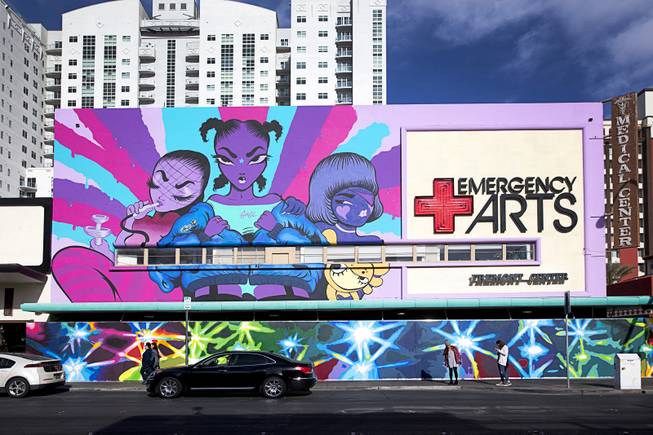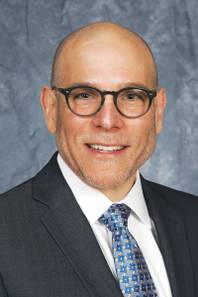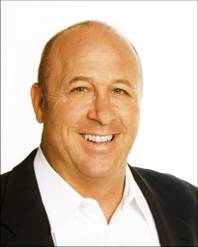
A mural by artist Jerry Misko, bottom, is shown at the Emergency Arts building in downtown Las Vegas Sunday, Dec. 11, 2016.
Sunday, May 21, 2017 | 2 a.m.

Jonathan Ullman

Marc Abelman
The Downtown Vegas Alliance was created in 2008 to attract and grow businesses, invest in development and generally improve quality of life in the area. Now 60 members strong, it has built partnerships with the business community, the nonprofit sector and the city of Las Vegas.
Newly elected board members include the executive director and CEO of the Mob Museum, Jonathan Ullman, who will serve as the organization’s chair; owner of Inside Style, Marc Abelman, the group’s secretary; BP2 Solutions’ Brian Knudsen, who was named vice chair; and the vice president of Bank of Nevada, Bill Paredes, treasurer.
The group has seen downtown grow by both “tangible and intangible means,” the former being the addition of businesses and projects and the latter being what they see as community buy-in and enthusiasm.
In the past decade, how has the downtown area changed, and what role has the Alliance played?
Ullman: Take the Mob Museum, for example. When we moved into what was the former (U.S.) Post Office and federal courthouse in February 2012, the city had moved out of City Hall and Zappos had not yet moved in. The Downtown Grand was not yet opened. It was fairly desolate down there. You could say much the same of the area to the east. Then you had the Mob Museum open, the Smith Center open, the Neon Museum open, the (Discovery) Children’s Museum open and the new City Hall open. These were major projects with enormous efforts by both public and private partnerships.
I think what has been equally exciting is the more organic growth you’ve seen on Fremont East with the investment in new restaurants and the shops that have come up in the Container Park and around on Carson Street. Even going farther out toward Maryland Parkway, you have Atomic Liquors and Chow. It’s such an exciting time. It’s hard to keep up nowadays. It used to be it was a major news story when you had a new restaurant. That’s not the case anymore.
Abelman: Before, you couldn’t find a good cup of coffee. ... It’s a community connector. You see it with Makers & Finders and Vesta. When it comes to Fremont East, I think about the addition of a bookstore and a record store. Those are the intrinsic businesses that add to the creative layer and value to the community.
Ullman: These are gathering points. They are landmarks for communities.
Public perception of the sustainability of downtown’s growth can really range. What do you think about investment and momentum in the neighborhood?
Abelman: On my block, the amount of investment coming in between Charleston (Boulevard) and California Street, and Casino Center (Boulevard) and Main Street, is extraordinary. Those new businesses are making a really significant investment. There is a lot of faith that’s going on.
Ullman: These are the type of development opportunities that require confidence that the community in the area is moving in the direction that can sustain capacity and drive the business required to be successful. That’s part of the tipping point we’ve moved over. Developers can recognize that this growth trajectory is going to continue.
How have you seen the quality of life change?
Ulman: When I think about quality of life, I think about choices. There are so many choices now. Where do you want to eat? Where do you want to go for entertainment? How do you want to spend your time? Where do you want to meet up with family and friends? That continues to grow and grow.
The downtown community and the city deserve enormous credit. They have proven they can do whatever they set their minds to, from building a performing arts center to the various initiatives done with a medical district being created. We’ve demonstrated and proven to ourselves that whatever we want to do, we can do it. It’s just deciding what’s most important to us.
While many of the businesses are somewhat new, there are businesses and people who have been in the area for years, if not decades. How do you go about bringing in older members of the community or older businesses and making sure they have a voice in what’s going on?
Ullman: We are conscious of making what we have accessible broadly. Certainly, being more entrenched and having more of a history in downtown Las Vegas is by no means a reason not to be involved. It’s the opposite. Folks who have more experience and have more of a stake because they’ve been here operating businesses for many years, they should absolutely feel welcomed. Why not participate in conversations about where we’re going and how we can improve downtown for everyone? If you want to be a part of that conversation, you should be part of this organization.
Abelman: If you’re excited about where we are going, we’re excited to have you.
What’s on the immediate horizon for the Alliance?
Ullman: We will be having a conversation about transportation. To put it in the simplest of terms, how do we make it easy to move people around downtown Las Vegas? How do you make it more walkable? How do you make it easier for people to find their way? How do you make it clearer to folks? If I’m not from Las Vegas, and I take the Deuce downtown and I’m walking around Fremont Street Experience and I want to go explore, how do we make it obvious and easier for people? You don’t want to miss out on what’s exciting at the Arts District or in the Cultural Corridor.
This is good for everyone. If we can move people around downtown, if we can show off all of our wares, that doesn’t take away from anybody’s profits. What it does is extends the interest and extends the amount of time people will visit. It makes all of downtown more of an attraction.
Visitor research shows people more and more are looking for an authentic experience. ... They want to go where the locals go. They want to have stories to tell and pictures to share that are not just the most common, but speak to what a city is all about.
Abelman: Let’s say you have somebody coming down here. They have coffee at a coffee shop and then go shopping and then they go to the bookstore and run into a friend who goes, ‘You wanna hear music tonight?’ That’s what we want.
Ullman: So when you go back to transportation, how do you make that experience possible without somebody required to get in a car and drive from point to point to point?

Join the Discussion:
Check this out for a full explanation of our conversion to the LiveFyre commenting system and instructions on how to sign up for an account.
Full comments policy